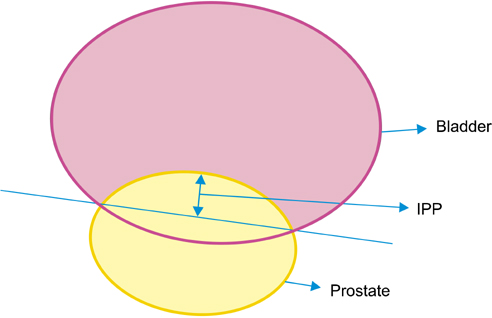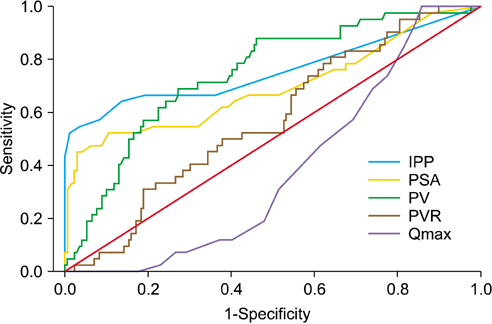Korean J Urol.
2013 Jun;54(6):369-372.
Defining the Degree of Intravesical Prostatic Protrusion in Association With Bladder Outlet Obstruction
- Affiliations
-
- 1Department of Urology, Korea University Guro Hospital, Seoul, Korea. dgmoon@korea.ac.kr
Abstract
- PURPOSE
The present study was done to define the degree of intravesical prostatic protrusion (IPP) causing bladder outlet obstruction (BOO) in patients with benign prostatic hyperplasia (BPH)/lower urinary tract symptoms.
MATERIALS AND METHODS
We retrospectively evaluated 239 patients with BPH, analyzing age, IPP, prostate volume, International Prostate Symptom Score (IPSS), and the results from a pressure-flow study. Urethral resistance was quantified by using the BOO index (BOOI), according to the formula BOOI=PdetQmax-2xQmax (where Pdet is detrusor pressure at the peak flow rate and Qmax is peak flow rate). BOO was defined by a BOOI above 40. Patients with a BOOI below 20 were excluded. Patients were classified into two groups (obstructed and unobstructed groups) by the BOOI. Correlations were determined by logistic regression analysis, and receiver operating characteristic curves were plotted to estimate the optimal cutoff for IPP.
RESULTS
There were significant differences in total prostate volume, postvoiding residual urine (PVR), IPP, and Qmax (p<0.001, p<0.001, p<0.001, and p=0.026, respectively) between the obstructed and unobstructed groups, but there were no significant differences in age (p=0.653), IPSS total score (p=0.624), or quality of life score (p=0.138). IPP had a significant prognosis (p<0.001) but was weakly correlated with prostate volume (p=0.026). The correlation coefficients between IPP and Qmax, PVR, prostate volume, and BOO were 0.551, -0.159, 0.225, and 0.391, respectively. For IPP, the area under the curve was 0.759 (95% confidence interval, 0.657 to 0.861) and the cutoff to indicate BOO was 5.5 mm with 66.7% sensitivity and 80.5% specificity.
CONCLUSIONS
An IPP exceeding 5.5 mm was significantly associated with BOO.
MeSH Terms
Figure
Reference
-
1. Abrams P. In support of pressure-flow studies for evaluating men with lower urinary tract symptoms. Urology. 1994; 44:153–155.2. Klingler HC, Madersbacher S, Djavan B, Schatzl G, Marberger M, Schmidbauer CP. Morbidity of the evaluation of the lower urinary tract with transurethral multichannel pressure-flow studies. J Urol. 1998; 159:191–194.3. Keqin Z, Zhishun X, Jing Z, Haixin W, Dongqing Z, Benkang S. Clinical significance of intravesical prostatic protrusion in patients with benign prostatic enlargement. Urology. 2007; 70:1096–1099.4. Lee LS, Sim HG, Lim KB, Wang D, Foo KT. Intravesical prostatic protrusion predicts clinical progression of benign prostatic enlargement in patients receiving medical treatment. Int J Urol. 2010; 17:69–74.5. Chia SJ, Heng CT, Chan SP, Foo KT. Correlation of intravesical prostatic protrusion with bladder outlet obstruction. BJU Int. 2003; 91:371–374.6. Nose H, Foo KT, Lim KB, Yokoyama T, Ozawa H, Kumon H. Accuracy of two noninvasive methods of diagnosing bladder outlet obstruction using ultrasonography: intravesical prostatic protrusion and velocity-flow video urodynamics. Urology. 2005; 65:493–497.7. Lim CS, Abrams P. The Abrams-Griffiths nomogram. World J Urol. 1995; 13:34–39.8. Netto Junior NR, D'Ancona CA, de Lima ML. Correlation between the International Prostatic Symptom Score and a pressure-flow study in the evaluation of symptomatic benign prostatic hyperplasia. J Urol. 1996; 155:200–202.9. el Din KE, Kiemeney LA, de Wildt MJ, Rosier PF, Debruyne FM, de la Rosette JJ. The correlation between bladder outlet obstruction and lower urinary tract symptoms as measured by the international prostate symptom score. J Urol. 1996; 156:1020–1025.10. Ezz el Din K, Kiemeney LA, de Wildt MJ, Debruyne FM, de la Rosette JJ. Correlation between uroflowmetry, prostate volume, postvoid residue, and lower urinary tract symptoms as measured by the International Prostate Symptom Score. Urology. 1996; 48:393–397.11. Mochtar CA, Kiemeney LA, van Riemsdijk MM, Laguna MP, Debruyne FM, de la Rosette JJ. Post-void residual urine volume is not a good predictor of the need for invasive therapy among patients with benign prostatic hyperplasia. J Urol. 2006; 175:213–216.12. Reis LO, Barreiro GC, Baracat J, Prudente A, D'Ancona CA. Intravesical protrusion of the prostate as a predictive method of bladder outlet obstruction. Int Braz J Urol. 2008; 34:627–633.
- Full Text Links
- Actions
-
Cited
- CITED
-
- Close
- Share
- Similar articles
-
- Unusual Bladder Stones -Report of Three Cases-
- Correlation of Male Overactive Bladder with Intravesical Prostatic Protrusion
- The Usefulness of Intravesical Prostatic Protrusion and Bladder Wall Thickness Measurement Using Transabdominal Ultrasound in Patients with Benign Prostatic Hyperplasia
- Effect of Bladder Outlet Obstruction on Blood Flow and Tissue Collagen in Rat Bladder
- Influence of Intravesical Prostatic Protrusion on Preoperative Lower Urinary Tract Symptoms and Outcomes after 120 W High Performance System Laser Treatment in Men with Benign Prostatic Hyperplasia



